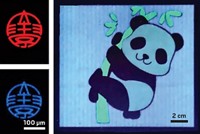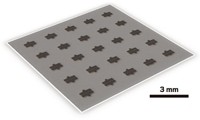Advertisement
Grab your lab coat. Let's get started
Welcome!
Welcome!
Create an account below to get 6 C&EN articles per month, receive newsletters and more - all free.
It seems this is your first time logging in online. Please enter the following information to continue.
As an ACS member you automatically get access to this site. All we need is few more details to create your reading experience.
Not you? Sign in with a different account.
Not you? Sign in with a different account.
ERROR 1
ERROR 1
ERROR 2
ERROR 2
ERROR 2
ERROR 2
ERROR 2
Password and Confirm password must match.
If you have an ACS member number, please enter it here so we can link this account to your membership. (optional)
ERROR 2
ACS values your privacy. By submitting your information, you are gaining access to C&EN and subscribing to our weekly newsletter. We use the information you provide to make your reading experience better, and we will never sell your data to third party members.
Analytical Chemistry
Heat Treatment and Chemical Additives Make More Mundane Stones Look Like Rare Gems
by Amanda Yarnell
February 2, 2004
| A version of this story appeared in
Volume 82, Issue 5
COVER STORY
Heat Treatment And Chemical Additives Make More Mundane Stones Look Like Rare Gems

IMPROVING ON NATURE
The rarer the gemstone, the more people are willing to pay for it. So perhaps not surprisingly, people have sought to use heat treatments or chemical additives to turn lesser quality stones into imitations of rare (and valuable) gems.
For diamonds, color is a major determinant of how much a given stone is worth. Completely colorless diamonds are worth more than diamonds with faint brown or yellow undertones. In the late 1990s, General Electric--the company that is credited with developing the first commercial process for synthesizing diamonds--introduced a method for improving the color of a select group of brownish-tinged natural diamonds.
The GE process depends on heating rare brownish diamond to more than 1,800 °C at 50,000–70,000 atm in a special furnace. This allows the defects in the carbon lattice that cause this diamond's brownish color to redistribute within the crystal. The result is diamond with substantially less color--one that looks just like its pricier colorless cousins.
Similar conditions can be used to turn a more common, less valuable type of brownish diamond into show-stopping fancy-colored diamond. Fancy-colored diamonds--those with deep, brilliant colors ranging from yellow to blue to red--are rare and carry steep price tags as jewels. Their colors come from impurities such as nitrogen (yellow) or boron (blue). Recently, a handful of companies in the U.S. have begun using high-pressure, high-temperature methods similar to GE's process to turn a fairly common type of brownish natural diamonds an unusual shade of yellow-green. Under these conditions, nitrogen impurities in the diamonds reorganize, producing the exotic color, notes Thomas M. Moses, vice president of identification services at the Gemological Institute of America (GIA) in New York City.
Alternatively, a combination of neutron or electron irradiation and annealing at 200–600 °C can be used to turn rare brownish natural diamonds more valuable shades of green-blue and orange-red. The irradiation step induces defects in the carbon lattice while the annealing step allows preexisting nitrogen impurities as well as the newly created defects to redistribute within the carbon lattice to give the new colors, Moses notes.
Attempts to transform ho-hum stones into rare, more costly gems are not limited to diamonds. In the past two years, the treatment of rubies and sapphires with beryllium at high temperatures has rocked the gem trade.
Both rubies and sapphires are made of corundum, an Al2O3 mineral. Red corundum (known as ruby) normally results from Cr3+ impurities that replace Al3+ in the crystal lattice. The colors of sapphires--which can range from the well-known blue to yellow, green, and purple--arise from the presence of Fe3+, Ti4+, Mg2+, and Cr3+ impurities, either alone or in combination.
Mild heat treatments have been used to improve the color of rubies and sapphires since ancient times, according to GIA research scientist Wuyi Wang. In the 1960s, it was realized that heating these gems at temperatures greater than 1,500 °C at atmospheric pressure dramatically improves their color--for instance, turning bluish-white sapphire to transparent blue. Such color improvement can result from the dissolution of titanium dioxide inclusions in the gems, Wang tells C&EN. Today, nearly all rubies and sapphires undergo similar heat treatments to improve their color, he adds.

Recently, a new chemical diffusion method to improve the colors of rubies and sapphires has emerged. Diffusion of Ti4+ into pale-colored sapphire had previously been shown to impart a deeper blue hue--but the effect was only skin-deep because of the ion's large size. Gem labs at GIA and elsewhere have revealed that Thai corundum dealers in the past few years have been diffusing beryllium into low-quality sapphires and rubies by heating the gems in the presence of chrysoberyl (BeAl2O4), a mineral commonly recovered with pink sapphires from Madagascar. This beryllium treatment yields colors previously seen only in the rarest of these gems [Gems & Gemol., 39, 84 (2003)]. "Virtually any naturally occurring color of ruby or sapphire can be reproduced by the beryllium-diffusion method," Wang notes.
Unlike with titanium diffusion, color produced by diffusion of smaller Be2+ ions can penetrate the entire stone. The color produced depends on how the Be2+ ions interact with other impurities and vacancies in the lattice of each gem, Wang tells C&EN. As few as five beryllium atoms per million atoms in the corundum lattice can generate dramatic color changes, he adds.
The use of heat treatments and chemical additives to improve the colors of diamonds, rubies, and sapphires has spurred gem labs across the world to identify spectroscopic techniques that can distinguish natural stones from treated facsimiles. Conventional gemological tests such as thermal conductivity can't be used to identify high-pressure-, high-temperature-treated diamond. Instead, expensive techniques like Raman photoluminescence or cathodoluminescence must be used to detect treated diamond's characteristic luminescence pattern.
Most beryllium-diffused stones also evade detection by traditional gemological testing. GIA has resorted to using expensive mass spectrometry-based techniques like secondary ion mass spectrometry and laser ablation-inductively coupled mass spectrometry to do the job. With the help of a GIA-prepared synthetic sapphire standard, Wang and his colleagues are able to quantify beryllium and other trace elements down to parts-per-million levels. But only a handful of gem labs can afford to use these MS-based methods. GIA and other gem labs are now working to develop a simple, low-cost alternative.
GIA, though, is more concerned that gem treatment methods are constantly evolving. Moses, Wang, and their GIA colleagues already suspect that diffusion of other light elements--like lithium, calcium, or boron--might also be used to alter corundum colors.






Join the conversation
Contact the reporter
Submit a Letter to the Editor for publication
Engage with us on Twitter